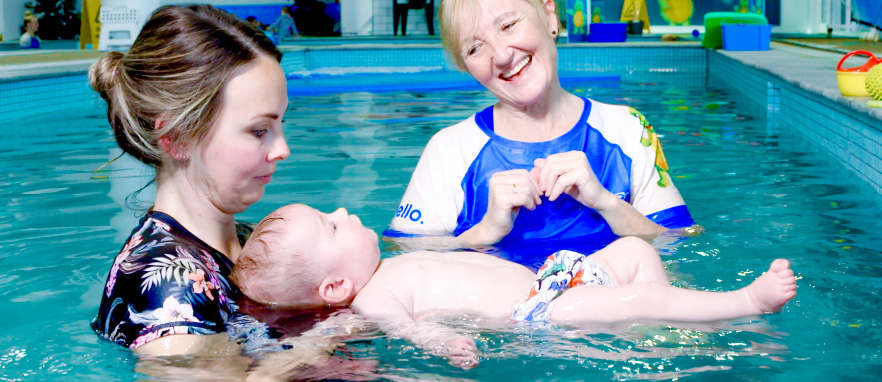Back Position Support
Baby Splash Program: Want to know how to best support your baby?

Emotional security is the key to a positive experience for your baby when learning to swim. With appropriate support your baby will become confident with the feeling of weightlessness.
Water lapping around the face is a calming experience for new babies. The natural position of a straight spine is perfect for being relaxed and experiencing buoyancy and balance. At home, the back float can be experienced in a shallow bath.
In the pool, the swishing movements of left and right your baby feels the soothing massage of the water across their body, whilst feeling the sensation of floating, bouncing, and swaying. Supporting your baby with the best hold to suit their needs will increase their sensory experience. Remember the water can support them, so there is no need to hold them tight. They won’t fall!
Cheek to cheek:
Facing your baby outward and placing their head on your shoulder, and one hand at the lower back, you can cuddle your baby cheek to cheek. Once they are more relaxed you can adjust the hold, so their head is on your chest. The more advanced hold is supported under the shoulders so they can fell their body float as you walk backward through the pool.
Face to face:
When positioning your baby facing you, lying them along your arms with their legs propped up against your chest, your little one is secure in the rhythmic rocking left and right and focusing on your smiles and singing.
Shoulder support:
Supporting them at the shoulders and walking backwards, focusing on you looking down from above increases their feeling of safety.
What if my baby cries?
Often the first experiences in the water are related to how they respond at bath time. Without correct support, your baby may be startled and feel like they are falling. The water is not causing your baby to cry but the support given to them. Often the hold is too tight, which is sending an alarming message to your baby they need to be fearful of what is occurring in their world.
If your baby’s arm flies out, it is a reflexive action, signally they fear they are going to fall. The appropriate support of the arms and a slow gentle motion into the pool and after, reduces the feeling of falling.
What if my baby lifts their legs up in the air?
Adjust your hold away from their back. The touch of a hand can activate the righting reflex, which triggers your baby to lift their legs to attempt to right themselves upright.
Added tip:
If the baby is crying and having trouble settling after a feed or in the middle of the night, use the skills learnt in swimming lessons to soothe your baby in the bath. Even lying your baby in the bath with the shower running over their feet is a soothing moment for your little one.